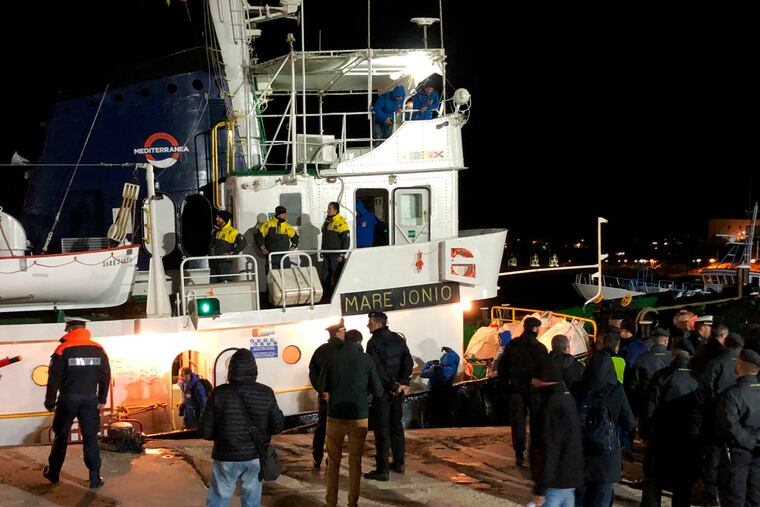Why Democrats should watch how the immigration firestorm is playing out in Italy | Trudy Rubin
Italian interior minister Matteo Salvini's harsh anti-migrant policies should be yet another warning to U.S. Democrats to take the lead on immigration at home.

Rome, Italy — In the plaza in front of the Tiburtina train station on the eastern half of this city, 100 African migrants huddle at night in rough blankets and sleeping bags provided by sympathetic citizens. Two scared, skinny Eritrean teenagers who’ve just arrived by boat from Libya cling to each other on a bench.
They are the visible symbols of the new, harsh immigration policy introduced by Matteo Salvini, Italy’s Interior Minister and most powerful politician. He hopes to ride the immigration issue all the way to becoming prime minister — and leader of a new far right movement in Europe.
Never mind that immigration to Italy in 2018 was 80 percent lower than in 2017 largely due to policies introduced by the center-left government that held power before Salvini took office. Yet the public largely credits the magnetic Matteo for the changes.
“Salvini hit the jackpot on immigration,” says Professor Roberto D’Alimonte, dean of political science at Rome’s LUISS Guido Carlo University. “He captured the mood of the country. Voters want to feel borders are borders.”
It’s hard not to feel that Salvini’s success holds important lessons for the Democratic Party, which needs a better strategy to counter Donald Trump’s manipulation of the immigration issue in the 2020 campaign.
Of course, the migrant problem in Italy is more daunting than the problems on our southern border. Think geography. Italy’s location on the Mediterranean just across from North Africa made it the obvious target for smugglers dispatching boatloads of migrants who had reached Libya. (Before Muammar Gaddafi’s death, Italian governments paid him to prevent such flows.)
Salvini’s center-left predecessor, Marco Minniti, renewed that approach, paying the Libyan government to stop the migrant flow. “We struck a deal with the Libyan Coast Guard, giving them tools,” says Sandro Gozi, a former Italian member of parliament and senior official who worked on the migration issue. “Before that the Libyans didn’t have enough vessels.”
The deal was imperfect; refugee holding pens in Libya are awful. But many Italian critics on the left and in the human rights community decried this solution without providing a viable alternative.
“They didn’t understand how salient the issue was,” says D’Alimonte. “Italians know there are millions of Africans who look at their cell phones and see the possibility of a better life,” he adds.
“The fact that boats of refugees were shown on TV made it seem like an invasion.” The perfect image for Salvini to project to spread fear.
With media skills that make Trump look like a piker, the interior minister pumps out videos proclaiming that “Africans don’t belong in Italy.” He plays on popular misconceptions that immigrants now make up one fourth of Italy’s population (in reality, says D’Alimonte, the figure is 7 to 8 percent).
Salvini pushed through a “parliamentary decree” closing the ports to humanitarian rescue ships carrying refugees. He has even threatened to fine humanitarians 5,500 euros ($6,140) for each refugee saved.
And he has eliminated aid for migrants who’ve reached Italy and are awaiting legal disposition of their cases, essentially dumping them on the streets, to the dismay of many small town mayors.
Salvini has even taken on the pope. I visited the Spin Time office building in Rome, occupied by 450 immigrants, where a representative of the pontiff made a personal trip to turn on electricity that was cut off because no one had paid the bills. Salvini’s response? “I expect the pope’s almoner also pays the 300,000 euros ($337,000) in debt,” he told a cheering crowd.
In other words, the immigrants were getting benefits not available to ordinary Italians.
That is a winning argument. According to a June 2018 Ipsos poll, 59 percent of the Italian public supports closing the ports to refugee ships, including nearly 30 percent of center-left voters.
As in America, this issue hits a vein.
Italians who defend immigration (as I do in America) rightly point out that Italy needs a population infusion. “We have to have these people,” says Emma Bonino, a senator and former cabinet minister. “Our demographic decline is humongous, our population the oldest on the continent.” Italy needs immigrants for agriculture, construction, and other less-skilled jobs.
But as Americans have learned in the Trump era, you can’t fight fear with facts. The immigration issue is tailor-made for merchants of fear looking not for solutions, but for votes.
There are rational solutions to Italy’s and Europe’s immigration problems, as Gozi points out. They would require bigger payments to the countries where immigrants originate, and more money for a European force to police Europe’s external borders. It would require Europe to coordinate its policy on asylum and sharing the refugee burden with countries like Italy that have absorbed the largest flow.
But, as in America, the immigration question here has become a political football that obstructs rational solutions. The center left has failed to boldly confront the security fears of voters who perceive an invasion. That has left the field open to demagogues like Salvini.
“The left will not become credible on immigration until it is credible on this issue of borders,” says D’Alimonte.
In America, the Democrats need to seize control of that border-security issue as well.